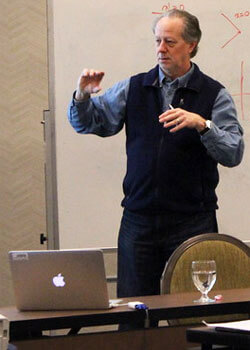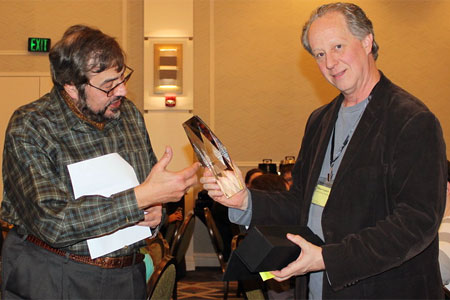Michael Syphers, a senior research professor of physics at NIU, received quite a surprise when he traveled recently to the University of Texas, Austin, to teach a course for the U.S. Particle Accelerator School (USPAS).
Syphers has taught similar USPAS courses for nearly three decades with little fanfare. During the school’s opening night ceremonies Jan. 24, the organization honored an unsuspecting Syphers with a special award for his exceptional contributions in teaching at USPAS sessions.
“We call it the Iron Man Award – it’s the first time we’ve given it out,” says Susan Winchester, USPAS manager, adding that both Syphers and Fermi National Accelerator Laboratory’s Don Cossairt were given the service awards.
“Mike has taught more courses and more students than any USPAS instructor,” Winchester says. “Many big names in the field credit him with helping them decide on a career in accelerator physics.”
One of those big names is John Byrd, program head of the Center for Beam Physics at Lawrence Berkeley National Laboratory in California. As a Ph.D. student at Cornell University in 1988, Byrd was working on experimental particle physics when he took a USPAS course co-taught by Syphers.
“Everybody has a few critical moments in their lives that they can look back on and wonder how they got so lucky,” Byrd says. “Choosing to go to the USPAS and getting Mike as a teacher is one of the pivotal moments in my career.”
After completing the course, Byrd went to his advisers and told them he wanted to change his field of study to accelerators. “I finally felt like I had found what I wanted to do,” Byrd says.

Michael Syphers teaching a course at the most recent U.S. Particle Accelerator School held at the University of Texas, Austin.
USPAS provides graduate-level training and workforce development in the science of particle beams and their associated accelerator technologies that are not otherwise available to the scientific and engineering communities.
Twice a year, the organization conducts two-week-long graduate and undergraduate level courses at leading U.S. universities. Since it began in 1987, the school has trained thousands of people from across the world in accelerator technology and design.
“At most universities, if they offered accelerator physics and beam technology courses, maybe one student would be qualified to take it, and the course would get canceled,” Winchester says. “So we open our three-credit-hour courses up to students from across the world. We see on average 150 students. Mike’s class is usually the biggest.”
Syphers has been with the school since 1988 and has taught more than 500 students. He also co-authored a textbook, “An Introduction to the Physics of High Energy Accelerators,” which was first published in 1992, has become a standard in the field and is used in USPAS courses.
“It is a matter of extreme pride and honor for the beam physics group in the NIU-Fermilab accelerator research cluster, for the Northern Illinois Center for Accelerator and Detector Development in the Department of Physics and for the entire NIU community to have an active research colleague honored for pedagogy in such a national forum. We can only aspire to grow from here,” says Swapan Chattopadhyay, professor and director of accelerator research at NIU and a member of the senior leadership team at Fermilab.
Syphers came to NIU in September, accepting a joint appointment with the university and Fermilab. Previously, he served for five years as a physics professor at Michigan State University. Before that, he had a long career as a scientist at several U.S. National Laboratories, predominantly at Fermilab.
“I came to NIU as a research professor to help engage NIU students in accelerator science and promote the field, building upon my strong ties with Fermilab,” Syphers says.
He added that he has always been interested in education. Before entering academia, USPAS fed this passion.
“It was a great honor to receive the ‘Iron Man’ award, and it has been very rewarding to hear all the congratulatory feedback from my friends and colleagues in the field,” Syphers says. “It is amazing how many people you can affect in that length of time.”

